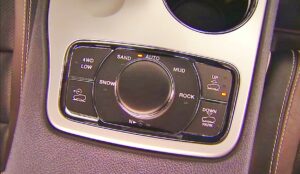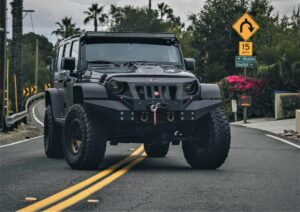Car manufacturers have over the years managed to improve the overall performance of cars. Modern SUVs like the Ford F150 and the Jeep Wrangler are some of the prime testaments of how much automotive engineering has improved.
One of the vehicle segments that has managed to vastly improve has to be the off road section. With futuristic technologies like the electronic locking axle and the ever reliable non-limited slip axle the off-road contingent has managed to not only survive but thrive.
There however seems to be slight confusion when it comes to differentiating between the two axle systems. If you are one of those people that are not sure how the two differ then this is the article for you. Keep reading!
Contents
Electronic Locking Axle
Locking differential technology has been existent for quite a while now and if you are a car enthusiast, then you know that locking differential technology is not new.
What is novel though about the electronic locking axle/differential is the fact that now it can be activated and controlled electronically.
Manual locking differentials are not only difficult to control but they are quite cumbersome and if our experiences with them is anything to go by then we have to say they can in some instances make driving difficult.
Working Principle of Electronic Locking Axle
The electronic locking axle system works pretty much the same way as your normal locking differential when activated but there is a small twist.
The electronic locking differential when inactivated allows the vehicle to work pretty much with an open differential system.
With the flick of a button or a knob, the electronic differential system will allow your vehicle to employ the locking differential system.
This means that when you realize that there is need for more traction you can push a button and allow power to be “locked” and be distributed equally to both ends of the axle.
The best part is with most modern electronic differential axles there is actually no need to press a button.
Thanks to advanced sensor technology, most vehicles with the electronic locking axle are able to switch on the locking differential system automatically. This means that as soon as there is a decrease in traction the locking system will turn on and power will be distributed equally to both ends of the axle.
If you are going for some off road driving or better if you fancy some rock climbing your vehicle will automatically switch on the locking differential system.
Once the terrain changes for the better the system will revert back to the open differential system.
This means that the last thing you will have to worry about is the wear and tear locking your differentials will have on your vehicle. Overall, it is a double win for the driver and also the vehicle.
Non-Limited Slip Axle
The non-limited slip axle is essentially the same thing as an open differential. We have already highlighted that it is the base feature for most cars.
The reason for this is because it allows drivers to upgrade in the future to more complex differential systems like the electronic Locking differential.
There is a lot of slander in the car community when it comes to the differential bit as you will find out when we discuss the working principle it might actually be way more useful than most people presume.
Add the price point to that and you have yourself a gem of a differential system.
Working Principle of the Non-Limited Slip Axle
The working principle of the non-limited slip axle is very simple. Several parts play an essential role in the entire mechanism of the vehicle.
The first one being the input pinion. This component is essential as it results in the rotation of the ring gear.
When a car is traveling in a straight trajectory, the input pinion rotates the cage as well as the ring gear. This will result in the drive wheels rotating at the same speed.
That is why the wheels will maintain a similar RPM. The input pinion will not result in the pinions that are enclosed inside the cage turning. This is what results in the maintenance of the RPM rate of the wheels.
The RPM rate of the wheels will change when the vehicle takes a turn. When a vehicle takes a turn there is a rotation in the cage.
The pinions that are enclosed in the cage of the vehicle will start to spin as the vehicle takes a turn. This will result in the wheel that is on the inside in relation to the turn being taken spinning slower than the outside wheel.
This is important, as taking a turn will be near impossible if the wheels are turning at the same speed.
The working principle of the non-limited slip axle affects how the vehicle performs on different terrains.
For starters, if you do drive your vehicle with the non-limited slip axle on ice it might be difficult.
We have already highlighted that the system provides equal amounts of torque to the wheels. This means that when you are on ice the wheel with the least traction will receive equal amount of torque as the wheel with the most traction.
In this case, the torque and overall friction between the wheels and the ice can get you in trouble.
The same applies for off road driving. If you are driving on off road terrain there are very high chances that a wheel or two will come off the ground. As we have already highlighted in a non-slip axle there is equal torque on all the wheels. This will result in all the wheels turning at the same rate including those that have come off the ground.
This means that you are going to have wheels spinning in mid-air. In practical terms, this is a waste of torque and this will significantly lower your chances of moving out of that situation.
If you were wondering why drivers end up upgrading their vehicles with systems like the electronic locking differential. This is the main reason why.
Differences between Electronic Locking Axle & Non- Limited Slip Axle
There are several differences between the electronic locking axle and the non-limited slip axle but the main driving principle behind the two significant automotive systems is to improve the overall driving experience in especially for off road driving.
In this regard both seem to do it quite well although there is a difference in the working principles of the equally effective system.
| Electronic Locking Axle | Non-Limited Slip Axle |
| Wheels turn at the same speed all the time | Power goes to the wheel with the less resistance |
| Switches on electronically | No switch available |
| Improves traction | Has no impact on traction |
| Best for off road driving | Great for paved and tarred roads |
| Aftermarket component | Factory component |
There is a large contrast between the electronic locking axle and the non-limited slip axle.
The good news though is each of the systems come with its own set of advantages. We are going to be discussing that in more detail in the next chapter.
Advantages of the Electronic Locking Axle
We have already discussed how the electronic locking axle works and it is only right that we look at why this might be the next big thing in the automotive world.
Compatibility
One thing about the electronic locking axle is that it is compatible with a large number of existing systems.
If you are using an ABS system or the VSES system, you can easily integrate it with the Electronic Locking Axle. This means that installation will not run you into extra costs.
There is a very small likelihood of having technical glitches because of adding the electronic locking axle.
Complete Axle Lock
Having your axle completely locked will greatly improve your traction. This means that overall you are not going to struggle when maneuvering the off road scene.
Economic
Although installation costs may be high at inception, once you have the electronic locking axle installed the last thing you have to worry about is maintenance costs.
There is no need to buy grease, as lubrication is not part of the electronic locking axle service kit. In fact, there really is nothing to put under the maintenance list.
This makes having the electronic locking differential an economic choice. The fact that the electronic locking axle can automatically switch off when on dry pavement means that you reduce overall wear on your vehicle massively.
Advantages of the Non-Limited Slip Axle
Regardless of its several shortcomings, the non-limited slip axle comes with several advantages.
Independent Wheel Rotation
In a non-limited slip axle, each wheel is not affected by the action of the other wheel. Each wheel will rotate independently regardless of the position or the rotation of any other wheel.
This means that even in situations where one wheel has low traction all the pressure will not be put on a single wheel.
This is a very important aspect, as it will help prevent problems like wheel hopping and excess tire wear. Die to the fact that the same torque is provided to the wheels there is no tire that will have to deal with excess torque.
If you are looking at maintaining vehicle stability especially on dry terrain at the same time without exposing your tires to excess strain then the non-limited slip axle system will do the magic.
Maintenance of Vehicle stability
If you want to park or generally drive in a high traffic, volume zone the non-limited slip axle system will give you a huge advantage.
The non-limited axle system allows wheels to rotate at different speeds as you take a turn. This means that you are not going to hear that squeaky annoying noise when taking turns and you are going to save your CV joints a lot of wear.
The non-limited slip system helps to maintain vehicle stability by allowing seamless turns. This is an important element especially when it comes to avoiding traffic accidents.
Conclusion
One thing about driving is that at one moment, you are going to need the electronic locking axle and at another, the point only the non-limited slip axle will do.
If your vehicle comes with the non-limited slip axle as the factory system it is a very good idea to get the aftermarket electronic locking differential installed.
This will greatly improve your driving experience and will ensure that your vehicle becomes a literal off road “warrior”.
If you enjoy off road driving and a bit of rock climbing the electronic locking axle will definitely suit your fancy. If you are a metro driver mainly driving on paved and tarred roads then the non-limited slip axle will do just fine.
You can know the Difference Between an Electronic Locking Differential and a Limited-Slip Differential through this guide.
Enjoy driving and keep it locked down with your electronic locking differential.



